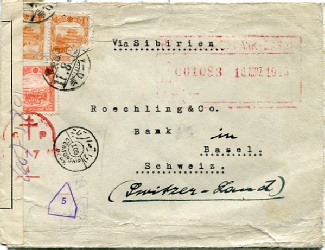
Cliquez sur les images pour agrandir -

LETTRE
18 août 1944 -
–
August 18th, 1944 -
|
Dimensions : |
158 x 120 mm |
|
|
Tarif : |
Lettre internationale, pour 20g… 20g supplémentaires…………… Total……………………………… Manque un timbre à 2 fens |
20 fens 12 fens 32 fens |
|
Période de valeur : |
01/04/1937 au 30/09/1944 |
|
|
Timbres utilisés : |
YT n°87 (paire) et 140 |
|
|
Oblitération : |
N°41.1 Moukden 18/08/1944 |
|
|
Période d’utilisation : |
24/01/1936 au 22/02/1945 |
|
|
Indication : |
(Switzer - Suisse manuscrit |
|
|
Transit : |
Marques de censure de Beyrouth et Le Caire |
|
|
Arrivée : |
Cachet du destinataire en date du 16 mars 1945 |
|
|
Size : |
158 x 120 mm |
|
|
Rate : |
Foreign letter, fisrt 20g…………. Added 20g………………………. Total……………………………… Missing one 2 fen stamp |
20 fen 12 fen 32 fen |
|
Period of rate : |
04/01/1937 to 09/30/1944 |
|
|
Stamps : |
SG n°90 and 150 |
|
|
Postmark : |
N°41.1 Mukden 08/18/1944 |
|
|
Period of use : |
01/24/1936 to 02/22/1945 |
|
|
Instruction : |
(Switzer - |
|
|
Transit : |
Censor marks in Beirut and Cairo |
|
|
Arrival : |
Private mark of adressee March 16th, 1945 |
|
Cette lettre a certainement été posté en urgence. Deux indices me laissent supposer ceci. D’abord, les timbres ont été mal collés, comme si l’expéditeur n’avait pas pris le temps d’humecter complètement la gomme. Le coin de l’un des timbres à 12 fens s’est replié vers le haut. Et l’oblitération a marqué cette partie. Le timbre à 6 fens est tenu par la bande de censure (mais ceci ne peut se voir que lorsque l’on a l’enveloppe en mains). Ensuite je suis certain que les 2 fens manquant on été omis par oubli mais qu’ils ont été payés au bureau de poste. Sinon l’enveloppe aurait été taxée.
Donc notre expéditeur est pressé, la lettre contenant des documents d’affaire -
Ce dont ne se doute pas notre expéditeur, c’est le délai d’acheminement que va subir ce courrier. Parti le 18 août 1944, il prend la direction de la Sibérie, puis de la Turquie. Mais comme la route au travers de la Bulgarie est fermée, il va se frayer un chemin vers une voie disponible.
Au Liban, les français sont présents à Beyrouth et lorsque la lettre arrive -
(1) Remerciements à R. Lanfranchi, A. Camelin, S. Gauthier Moreau, J. Spetch -
(2) Source : www.histoire-
(3) Remerciement à M. Letaillieur membre de la Royal Philatelic Society de Londres pour ce complément d’information.


This letter was certainly posted in a hurry. Two clues lead me to believe this. Firstly, the stamps have been badly glued, as if the sender hadn't taken the time to completely moisten the gum. The corner of one of the 12 fen stamps has bent upwards. The cancellation marked this area. The 6 fen stamp is held by the censor strip (but this can only be seen when you have the envelope in your hands). Then I'm sure that the missing 2 fen were omitted by oversight, but that they were paid for at the post office. Otherwise the envelope would have been taxed.
So our sender is in a hurry: the letter containing business documents -
What our sender has no idea about is the time it will take for the mail to reach its destination. Leaving on August 18th, 1944, it headed for Siberia, then Turkey. But as the route through Bulgaria was closed, it had to make its way to an available route.
In Lebanon, the French are present in Beirut, and when the letter arrives -
(1) Thanks to R. Lanfranchi, A. Camelin, S. Gauthier Moreau, J. Spetch -
(2) Source: www.histoire-
(3) Thanks to Mr. Letaillieur, member of the Royal Philatelic Society of London, for this additional information.